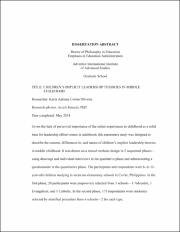| dc.description.abstract | Given the lack of perceived importance of the initial experiences in childhood as a solid
base for leadership effectiveness in adulthood, this exploratory study was designed to
describe the content, differences in, and nature of children’s implicit leadership theories
in middle childhood. It was drawn on a mixed methods design in 2 sequential phases—
using drawings and individual interviews in the qualitative phase and administering a
questionnaire in the quantitative phase. The participants and respondents were 8- to 11-
year-old children studying in sectarian elementary schools in Cavite, Philippines. In the
first phase, 28 participants were purposively selected from 3 schools—1 Adventist, 1
Evangelical, and 1 Catholic. In the second phase, 175 respondents were randomly
selected by stratified procedure from 6 schools—2 for each type.
Jesus was the most frequently nominated leader of the children (39.2% in the first
phase and 25.7% in the second phase). There was a preference for the male stereotype for
leadership in both phases (about 65%). A religious figure was the preferred role for a
leader in the qualitative phase (43.4%). Parenting as a role was the most mentioned in the
quantitative phase (41.1%). Eighteen leader’s attributes were categorized into 4 factors:
(a) socio-emotional, (b) spiritual-moral, (c) cognitive, and (d) physical. The highest
ranked leader’s attributes were (a) to provide spiritual guidance, (b) to perceive
leadership as a learning journey, and (c) to be kind or caring towards others. Males, older
children, and non-Catholic respondents were more likely to choose male leaders. Girls,
Catholics, and young children were more likely to nominate a female leader. While boys
and non-Catholic children valued spiritual guidance, girls considered teaching and
humility as their desired leader’s attributes. Older children were more likely to choose a
religious figure as leader’s role than the young children. Two leadership attributes
increased with age—teaching among Adventist children and humility among Evangelical
and Adventist respondents. The perception of intelligence as an important attribute of
leadership was stronger among 8-year-old Catholic children. These results point out the
holistic and cultural nature of implicit leadership theories, which were individually and
socially constructed reflecting the educational gains, ongoing moral development, and the
shared values of the local culture. These results suggest that familial relations,
educational experiences, and religious training were influential forces for the
development of implicit leadership theories during this life stage. | en_US |

